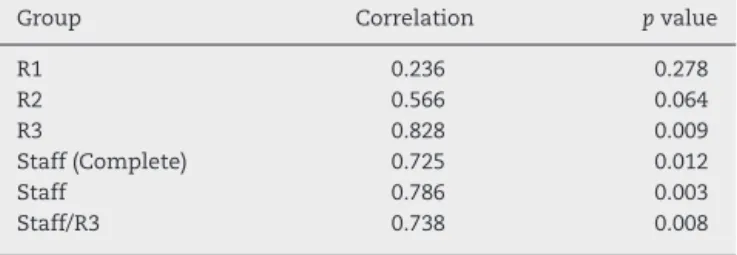w w w . r b o . o r g . b r
Original
article
Statistical
analysis
on
the
concordance
of
the
radiological
evaluation
of
fractures
of
the
distal
radius
subjected
to
traction
夽
Daniel
Gonc¸alves
Machado,
Sergio
Auto
da
Cruz
Cerqueira,
Alexandre
Fernandes
de
Lima,
Marcelo
Bezerra
de
Mathias,
José
Paulo
Gabbi
Aramburu,
Rodrigo
Ribeiro
Pinho
Rodarte
∗HospitalCentraldaPolíciaMilitardoRiodeJaneiro,RiodeJaneiro,RJ,Brazil
a
r
t
i
c
l
e
i
n
f
o
Articlehistory:
Received3November2014 Accepted29December2014 Availableonline21January2016
Keywords:
Fracturesoftheradius Radiography
Traction
a
b
s
t
r
a
c
t
Objective:Theobjectiveofthisstudywastoevaluatethecurrentclassificationsfor frac-turesofthedistalextremityoftheradius,sincetheclassificationsmadeusingtraditional radiographsinanteroposteriorandlateralviewshavebeenquestionedregardingtheir repro-ducibility.Intheliterature,ithasbeensuggestedthatotheroptionsareneeded,suchasuse ofpreoperativeradiographsonfracturesofthedistalradiussubjectedtotraction,with strati-ficationbytheevaluators.Theaimwastodemonstratewhichclassificationsystemspresent betterstatisticalreliability.
Results:IntheUniversalclassification,theresultsfromthethird-yearresidentgroup(R3)and fromthegroupofmoreexperiencedevaluators(Staff)presentedexcellentcorrelation,with astatisticallysignificantp-value(p<0.05).Neitherofthegroupspresentedastatistically significantresultthroughtheFrykmanclassification.IntheAOclassification,therewere highcorrelationsintheR3andStaffgroups(respectively0.950and0.800),withp-values lowerthan0.05(respectively<0.001and0.003).
Conclusion: Itcanbeconcludedthatradiographsperformedundertractionshowedgood con-cordanceintheStaffgroupandintheR3group,andthatthisisagoodtacticforradiographic evaluationsoffracturesofthedistalextremityoftheradius.
©2016SociedadeBrasileiradeOrtopediaeTraumatologia.PublishedbyElsevierEditora Ltda.Allrightsreserved.
夽
WorkperformedintheOrthopedicsandTraumatologyService,HospitalCentraldaPolíciaMilitardoRiodeJaneiro,RiodeJaneiro,RJ, Brazil.
∗ Correspondingauthor.
E-mail:rrodarte@globo.com(R.R.P.Rodarte).
http://dx.doi.org/10.1016/j.rboe.2014.12.010
Análise
estatística
da
concordância
na
avaliac¸ão
radiológica
das
fraturas
de
rádio
distal
submetidas
a
trac¸ão
Palavras-chave: Fraturasdorádio Radiografia Trac¸ão
r
e
s
u
m
o
Objetivo: Avaliarasclassificac¸õesatuaisdafraturadaextremidadedistaldorádio,poisas classificac¸õesfeitasemradiografiastradicionaisnasincidênciasanteroposterioreperfiltêm sidoquestionadasquantoasuareprodutibilidadeeésugeridapelaliteraturaanecessidade deoutrasopc¸ões,comousodasradiografiaspré-operatóriassubmetidasatrac¸ãodefraturas derádiodistal,estratificadospelosavaliadores,comvistasademonstrarquaisclassificac¸ões apresentammelhorconfiabilidadeestatística.
Resultados: Naclassificac¸ãoUniversalosresultadosdosgruposdeR3eStaffapresentaram umaótima correlac¸ão,comum p-valorestatisticamentesignificativo (p<0,05). Quando avaliadaa classificac¸ãode Frykman,nenhumgrupoapresentouum resultado estatisti-camente significativo.Na classificac¸ão AO,nosgrupos R3 eStaff, a correlac¸ãofoi alta (respectivamente0,950e0,800)comump-valorabaixode0,05(respectivamente<0,001 e0,003).
Conclusão: Atrac¸ãoparafeituradasradiografiassemostroucomumaboaconcordância principalmentenosgruposavaliadoresdemaiorexperiência(Staff)enoresidentede3o anoeéumaboatáticanaavaliac¸ãoradiográficadafraturadaextremidadedistaldorádio. ©2016SociedadeBrasileiradeOrtopediaeTraumatologia.PublicadoporElsevier EditoraLtda.Todososdireitosreservados.
Introduction
Fracturesofthedistalextremityofthe radiusarevery fre-quentinjuriesnowadaysandthis,alongwithtechnological advances,hasledtomuchdebateamongorthopedistswith regardtoimprovementoftheirtreatment.1
Thedifferentapproachesandoutcomeshavestimulated authorstoseekclassificationsystemsthatwouldguide diag-nosisandtreatment.2Classificationsforthedistalextremity oftheradiushavetheaimsofrankingtheinjuries,enabling betterknowledgeandservingasfacilitatorsinthe decision-making process, either for conservative treatment or for surgicaltreatment,andwithregardtothelatter,determining whichtechniquewouldbebest.Awidevarietyofmethodsfor treatingthedistalextremityoftheradiusexists,3goingfrom conservativetosurgicaltreatment,usingdifferenttechniques (fixationusingKirschnerwires;ligamentotaxisusingan exter-nalfixatorwithorwithoutassociatedKirschnerwires;open reductionusingrigidinternalfixation;andabsolute stabiliza-tionbymeansofosteosynthesisusingaplateandscrewswith orwithoutgrafting).Useofimagingtechnologyfor classifica-tionswithinorthopedicshasbeenanalyzedbyresearchers,4 inrelationtoradiography,5,6computedtomographyor mag-netic resonance imaging.7 The reproducibility of fracture evaluationsthroughusingclassificationsystemsisextremely importantforreliability.Useofsuchsystemsisanimportant stageinquantifyingtheseverityoftheinjuryandthis demon-stratesthesafetyofusingcertainclassifications.8–11Interand intraobserverconsistencyisaprerequisiteforefficientuseof anyclassificationsystem.
Classificationsthataremadeusingtraditionalradiographs inposteroanterior and lateral views have been questioned regardingtheirreproducibility.INtheliterature,ithasbeen
suggested that there is a need for other options, such as computed tomography.9 However,amongthelimitationsof computedtomographyisitsgreatercostandhigherradiation doseinrelationtoradiography.Radiographyperformedunder tractionisamongtheotheroptionsoflowercostandgreater practicality,andthismayincreasethereliabilityofanalyses onjointfractures.12
Theobjectiveofthisstudywastoevaluatethecurrent clas-sificationsystemsforfracturesofthedistalradiusbymeans of preoperative radiographs produced under traction, with stratificationbytheevaluators, withaviewto demonstrat-ing whichclassificationsystemspresentthe beststatistical reliability.
Methodology
A retrospective observational study was conducted in our institutionbasedon30radiographsonpatientswhohadbeen admitted tothe orthopedicsand traumatology service and whounderwentsurgicalprocedurestotreatfracturesofthe distalextremityoftheradius.
Theauthorsdeclarethatthisstudywasinaccordancewith theDeclarationofHelsinki.
Universalclassification(Cooney)
I. extra-articularwithoutdisplacement II. extra-articularwithdisplacement
A. stableandreducible B. unstableandreducible C. irreducible
III. intra-articularwithoutdisplacement IV. intra-articularwithdisplacement
A. stableandreducible B. unstableandreducible C. irreducible
D. complex
Frykmanclassification
I. extra-articular
II. extra-articular+fracturingofthedistalulna III. intra-articular(radiocarpaljoint)
IV. intra-articular(radiocarpaljoint)+fracturingofthedistal ulna
V. intra-articular(distalradioulnarjoint)
VI. intra-articular(distalradioulnarjoint+fracturingofthe distalulna
VII. intra-articular(radiocarpalanddistalradioulnarjoints) VIII. intra-articular (radiocarpal and distal radioulnar
joints)+fracturingofthedistalulna
AOclassification
A–extra-articular
A1–ulnaandradiusintact
A2–simpleandimpactedfracturesoftheradius A3–multifragmentedfractureoftheradius
B–partialintra-articular
B1–sagittalfactureoftheradius
B2–frontalanddorsaledgefractureoftheradius B3–frontalandvolaredgefractureoftheradius
C–completeintra-articularfractureoftheradius
C1–simpleatjointandsimpleinmetaphysis
C2–simpleatjointandmultifragmentedinmetaphysis C3–multifragmentedatjoint
Eachgroupaccordingtoyearofresidencycomprisedthree residents. Thus, three evaluators were first-year residents, threewere second-yearresidentsandthreewere third-year residents.Threestaffphysiciansalsoformedpartofthegroup, asareferencegroup.
Statisticalanalysis
Theresultsfromanalyzingtheradiographswithregardtothe differentclassificationsystems(Frykman,AOandUniversal) weretabulatedandtheSPSSstatisticalpackage(IBM),version 13.0,wasusedfortheconcordanceanalysis.
Firststage:exploratoryanalysisofthecentraltrendand dispersionmeasurementsonthevariablesobtained.
Secondstage:evaluationoftheintraandinter-group inter-examinerconcordance(R1/R2/R3andStaff)bymeansofthe intraclasscorrelation(ICC).
Thirdstage:identificationofconcordancebetweenthe con-trolgroup(Staff)andR3intheuniversalclassificationwithand withoutthesubtypes.
Results
Thethreeclassificationspresentedverydifferentresultsin correlationsthatweremadewiththeaimofexaminingthe consistencyoftheevaluationsbetweenthegroupsof evalua-tors.
In evaluating the universal classification proposed by Cooney,13 thegroups ofevaluators presentedbehaviorthat differedgreatly.
Thegroupoffirst-yearresidentspresentedlow concord-ance(0.236),withlowstatisticalsignificance(p-value=0.278). Thegroupofsecond-yearresidentspresentedgreater con-cordance,althoughstillatanintermediatelevel(0.566),with ap-valueof0.064,whichwasatthelimitofsignificance.
The results from the R3 and Staff groups presented excellent correlations, withstatisticallysignificant p-values (p<0.05).When theCooneyclassificationwasusedwithout evaluatingthecriterionofstabilityofposition(fullStaff ver-susStaff),theconcordancewasseentoincrease(from0.725 to0.786),withasignificantp-value(p<0.05).WhentheR3and Staffgroupswerecompared,thisshowedhighconcordance betweenthegroups(Table1).
WhentheFrykmanclassificationwasevaluated,noneof the groupspresentedastatisticallysignificantresult(allof thempresentedp-values>0.05),althoughtheStaffgroup pre-sentedanadequatecorrelation(0.885)(Table2).
AnalysisontheAOclassificationshowedthatthegroups presentedbehavioraldifferences(Table3).
TheR1grouppresentedlowconcordanceandalsoap-value withlowstatisticalsignificance.
TheR2grouppresentedgoodcorrelation,withap-valueof 0.032(statisticallysignificant).
For the R3 and Staff groups, the correlationswere high (respectively 0.950 and 0.800), withp-valuesless than 0.05 (respectively<0.001and0.003).
Table1–Analysisontheintraclasscorrelationbetween thegroupsofevaluatorsusingCooney’suniversal classificationsystem.
Group Correlation pvalue
R1 0.236 0.278
R2 0.566 0.064
R3 0.828 0.009
Staff(Complete) 0.725 0.012
Staff 0.786 0.003
Staff/R3 0.738 0.008
Table2–Analysisontheintraclasscorrelationbetween thegroupsofevaluatorsusingFrykman’sclassification system.
Group Correlation pvalue
R1 0.222 0.302
R2 0.557 0.077
R3 0.515 0.159
Staff 0.885 0.835
Source:Hospital.
Table3–Analysisontheintraclasscorrelationbetween thegroupsofevaluatorsusingtheAOclassification system.
Group Correlation pvalue
R1 0.057 0.432
R2 0.656 0.032
R3 0.95 <0.001
Staff 0.8 0.003
Source:Hospital.
Discussion
Fracturesofthedistalextremityoftheradiusareamongthe mostfrequenttypesoffracturesoftheskeleton,accordingto Reisetal.,14andaccountforupto10%ofskeletalfractures. Paksimaetal.15statedthattheyareresponsibleforoneinsix emergencyorthopediccasesattended.
Theconcernforobservingradiographicresultsinrelation tofunctionaloutcomeshasbeenevaluatedrecently.16
Theinitialstatusofthefracture,3alongwiththe comminu-tion,isconsideredtobeafactorthatcontributestowardthe outcomefromthefracture.
Theexistenceofvariousclassificationsdemonstratesthat thereisaneedtoobtainasingleidealclassificationthatwould beverywide-rangingand wouldprovidesupportfor thera-peuticandprognosticconduct.17Morethan20classification systemsforfracturesofthedistalextremityoftheradiushave beendescribed.Ifaclassificationsystemhasfulfilledallthe premisesforsupplyingsupport,itwillstillneedtopresent intraandinterobserverreproducibility.Severalauthorshave statedthat choosingtheidealtreatmentforstabilizing the fracture is of fundamental importance.3,10,15 According to DowningandKarantana,18no otherfracture treatmenthas been influenced bytechnology inthe way thattreatments forfracturesofthe distalextremityoftheradiushave.18,19 Therefore,theprospectofmakinganappropriatediagnosis, classifyingthefracturewithgreaterreproducibilityand reli-ability and choosing the most appropriate technique have becomethepillarsforachievingthebestresultpossible.20–22 Recognizingthe characteristicsofthe fractureisextremely important,23–25sincecertainfactorsthatpredictinstability,as describedbyLafontaineetal.,26needtobewellrecognizedin makingtheradiographicassessment.
Inastudy onradiographicassessmentwithouttraction, Flinkkiläetal.27suggestedthattheAOandFrykman classifi-cationspresentedlowvalueandthatthiswasaccompanied
bylowconcordanceregardingtheclinicaloutcome.The per-centage concordancebetween different evaluators through usingthecomplete AOclassificationhasrangedfrom17to 40%fromradiographsandfrom17to50%fromtomography. InthestudybyKrederetal.,28theinterobserverconcordance valuesfromtheAOclassificationwas0.67betweenresidents and 0.86 between surgeons, through evaluating the major types (A, Band C). When all the subtypes were used, the concordancedecreasedto0.25and0.42,respectively.Useof additionaltoolssuchascomputedtomographyhastheaim ofimprovingtheclassification.Betterresultswithregardto identifyingthepresenceorabsenceofsixspecificfragments of thefracture (radial column, dorsal wall, dorsoulnar cor-ner,volar-ulnarcorner,volaredgeandcentralimpaction),so astomaketreatmentrecommendations arefoundthrough radiography undertraction and computed tomography.9 In ourstudy,weobservedagoodcorrelationthroughthe uni-versalclassification.TheFrykmanclassificationshowedalow levelofconcordanceinthepresentstudy,andthiswasinline withtheliterature.Ontheotherhand,theAOclassification presentedexcellentconcordance.AccordingtoKüc¸üketal.,22 theclassificationsystemsforevaluatingfracturesofthe dis-talextremityoftheradiuspresentedinconsistentresultsand theysuggestedthattherewasaneedtocreatenew classi-fications. Inthestudy byEvans etal.,29,30 the sensitivityof radiographsformakingclassificationsusingtheFrykmanand AOsystemswasonly12.5%.Theseauthorsstatedthat evalua-tionsusingradiographsalonewereinsufficientandsuggested thattherewasaneedforothertypesofexaminationsinorder toincreasethereliabilityandreproducibility,aswefoundin thepresentedstudy,inwhichweachievedgoodconcordance usingtheuniversalandAOclassificationsystems.
Conclusion
In the present study, it was observed that evaluations on radiographs produced under traction presented high concordance through the AO and universal classification systems.
RegardingtheFrykmanclassification,wedidnotfindgood reliabilityfromthisevaluation,evenonradiographsproduced undertraction.
We conclude that radiographs produced under traction showed good concordance, especially in the groups with greaterexperiencethatwereevaluated(staffandthird-year residents),andthatthisisagoodtacticinmakingradiographic assessmentsoffracturesofthedistalextremityoftheradius throughCooney’suniversalclassificationandtheAO classifi-cation.
Conflicts
of
interest
Theauthorsdeclarenoconflictsofinterest.
r
e
f
e
r
e
n
c
e
s
classifyingfracturesofthedistalextremityoftheradius– descriptionandreproducibility.SaoPauloMedJ.2013;(4): 252–6.
2. NeuhausV,BotAG,GuittonTG,RingDC.Influenceofsurgeon, patient,andradiographicfactorsondistalradiusfracture treatment.JHandSurgEurVol.2015;40(8):796–804.
3. MakhniEC,EwaldTJ,KellyS,DayCS.Effectofpatientageon theradiographicoutcomesofdistalradiusfracturessubjectto nonoperativetreatment.JHandSurgAm.2008;33(8):1301–8.
4. SilvaCFB,CâmaraEKB,VieiraLA,AdolphssonF,RodarteRRP. Radiographicassessmentoftheopeningwedgeproximal tibialosteotomy.RevBrasOrtop.2010;45(4):439–43.
5. HerzbergG.Acutedistalradiusfracture:PAFanalysis.JWrist Surg.2012;1(1):81–2.
6. MachadoDG,CerqueiraSAdaC,RodarteRRP,NettoA,Souza CA,MathiasMB.Análiseestatísticadosresultadosfuncionais eradiográficosapósutilizac¸ãodeplacavolarbloqueadanas fraturasdaextremidadedistaldorádio.RevBrasOrtop. 2012;47(3):297–303.
7. KümmelA,EbnerL,KrausM,MauchF,GeyerT,MentzelM, etal.Magnetresonanceimagingincommoninjuriesofthe wrist.Unfallchirurg.2014;117(3):221–6.
8. AndersenDJ,BlairWF,SteyersCMJr,AdamsBD,el-KhouriGY, BrandserEA.Classificationofdistalradiusfractures:an analysisofinterobserverreliabilityandintraobserver reproducibility.JHandSurgAm.1996;21(4):574–82.
9. AveryDM3rd,MatulloKS.Distalradialtractionradiographs: interobserverandintraobserverreliabilitycomparedwith computedtomography.JBoneJointSurgAm.2014;96(7):582–8.
10.KuralC,SungurI,KayaI,UgrasA,ErtürkA,CetinusE. Evaluationofthereliabilityofclassificationsystemsusedfor distalradiusfractures.Orthopedics.2010;33(11):801.
11.GradlG,NeuhausV,FuchsbergerT,GuittonTG, PrommersbergerKJ,RingD.ScienceofVariationGroup Radiographicdiagnosisofscapholunatedissociationamong intra-articularfracturesofthedistalradius:interobserver reliability.JHandSurgAm.2013;38(9):1685–90.
12.GoldwynE,PensyR,O’TooleRV,NasconeJW,SciadiniMF, LeBrunC,etal.Dotractionradiographsofdistalradial fracturesinfluencefracturecharacterizationandtreatment?J BoneJointSurgAm.2012;94(22):2055–62.
13.CooneyWP.FracturesofthedistalradiusAmodern treatment-basedclassification.OrthopClinNorthAm. 1993;24(2):211–6.
14.ReisFB,FaloppaF,SaoneRP,BoniJR,CorveloMC.Fraturasdo terc¸odistaldorádio:classificac¸äoetratamento.RevBras Ortop.1994;29(5):326–30.
15.PaksimaN,PanchalA,PosnerMA,GreenSM,MehimanCT, HiebertR.Ameta-analysisoftheliteratureondistalradius fractures:reviewof615articles.BullHospJtDis.
2004;62(1–2):40–6.
16.XavierCRM,DalMolinDC,SantosRMM,SantosRDT,Ferreira NetoJC.Surgicaltreatmentofdistalradiusfractureswitha
volarlockedplate:correlationofclinicalandradiographic results.RevBrasOrtop.2011;46(5):505–13.
17.JeongGK,KaplanFT,LiporaceF,PaksimaN,KovalKJ.An evaluationoftwoscoringsystemstopredictinstabilityin fracturesofthedistalradius.JTrauma.2004;57(5):1043–7.
18.DowningND,KarantanaA.Arevolutioninthemanagement offracturesofthedistalradius?JBoneJointSurgBr. 2008;90(10):1271–5.
19.KarantanaA,DowningND,ForwardDP,HattonM,TaylorAM, ScammellBE,etal.Surgicaltreatmentofdistalradial fractureswithavolarlockingplateversusconventional percutaneousmethods:arandomizedcontrolledtrial.JBone JointSurgAm.2013;95(19):1737–44.
20.SinkEL,LeunigM,ZaltzI,GilbertJC,ClohisyJ.Academic NetworkforConservationalHipOutcomesResearchGroup Reliabilityofacomplicationclassificationsystemfor orthopaedicsurgery.ClinOrthopRelatRes.
2012;470(8):2220–6.
21.SiripakarnY,NiempoogS,BoontanapibulK.Thecomparative studyofreliabilityandreproducibilityofdistalradius’ fractureclassificationamong:AOfrykmanandFernandez classificationsystems.JMedAssocThai.2013;96(1):52–7.
22.Küc¸ükL,KumbaracıM,GünayH,KarapınarL,OzdemirO. Reliabilityandreproducibilityofclassificationsfordistal radiusfractures.ActaOrthopTraumatolTurc.
2013;47(3):153–7.
23.ArealisG,GalanopoulosI,NikolaouVS,LaconA,AshwoodN, KitsisC.DoestheCTimproveinter-andintra-observer agreementfortheAO,FernandezandUniversalclassification systemsfordistalradiusfractures?Injury.
2014;45(10):1579–84.
24.KovalK,HaidukewychGJ,ServiceB,ZirgibelBJ.Controversies inthemanagementofdistalradiusfractures.JAmAcad OrthopSurg.2014;22(9):566–75.
25.BeumerA,AdlercreutzC,LindauTR.Earlyprognosticfactors indistalradiusfracturesinayoungerthanosteoporoticage group:amultivariateanalysisoftraumaradiographs.BMC MusculoskeletDisord.2013;14:170.
26.LafontaineM,HardyD,DelinceP.Stabilityassessmentof distalradiusfractures.Injury.1989;20(4):208–10.
27.FlinkkiläT,RaatikainenT,HämäläinenM.A.O.Frykman’s classificationsofColles’fractureNoprognosticvaluein652 patientsevaluatedafter5years.ActaOrthopScand. 1998;69(1):77–81.
28.KrederHJ,HanelDP,McKeeM,JupiterJ,McGillivaryG, SwiontkowskiMF.ConsistencyofAOfractureclassification forthedistalradius.JBoneJointSurgBr.1996;78(5):726–31.
29.EvansS,TaithongchaiA,MachaniB,DavidM.Areplain radiographsusefulinaccuratelyclassifyingdistalradius fractures?IntJSurg.2013;11(8):707.

